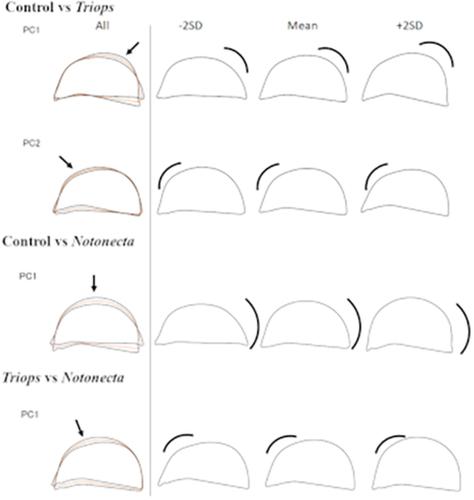当前位置:
X-MOL 学术
›
J. Morphol.
›
论文详情
Our official English website, www.x-mol.net, welcomes your
feedback! (Note: you will need to create a separate account there.)
Predator‐specific inducible morphological defenses of a water flea against two freshwater predators
Journal of Morphology ( IF 1.5 ) Pub Date : 2020-04-25 , DOI: 10.1002/jmor.21131 Sven Ritschar 1 , Max Rabus 1 , Christian Laforsch 1
Journal of Morphology ( IF 1.5 ) Pub Date : 2020-04-25 , DOI: 10.1002/jmor.21131 Sven Ritschar 1 , Max Rabus 1 , Christian Laforsch 1
Affiliation

|
The expression of inducible morphological defenses in Daphnia in response to a single predator is a well‐known phenomenon. However, predator‐specific modifications of the same defensive traits as an adaption to different predator regimes is so far only described for Daphnia barbata. It is unknown if this accounts only for this species or if it is a more widespread, general adaptive response in the genus Daphnia. In the present study, we therefore investigated whether a clone of the pond‐dwelling species Daphnia similis responds to different predatory invertebrates (Triops cancriformis; Notonecta maculata) with the expression of predator‐specific modifications of the same defensive traits. We showed that Triops‐exposed individuals express a significantly longer tail‐spine, while body width decreased in comparison to control individuals. Additionally, they also expressed inconspicuous defenses, that is, significantly longer spinules on the dorsal ridge. The Notonecta‐exposed D. similis showed a significantly longer tail‐spine, longer spinules and a larger spinules bearing area on the dorsal ridge than control individuals as well. However, a geometric morphometric analysis of the head shape revealed significant, predator‐specific changes. Triops‐exposed individuals expressed a flattened head shape with a pronounced dorsal edge, while Notonecta‐exposed individuals developed a high and strongly rounded head. Our study describes so far unrecognized inducible defenses of D. similis against two predators in temporary waters. Furthermore, the predator‐dependent change in head shape is in concordance with the ‘concept of modality’, which highlights the qualitative aspect of natural selection caused by predators.
中文翻译:

水蚤对两种淡水捕食者的捕食者特异性诱导形态防御
水蚤在响应单个捕食者时表达可诱导的形态防御是一个众所周知的现象。然而,迄今为止,仅针对水蚤描述了相同防御特征的捕食者特异性修改,以适应不同的捕食者制度。目前尚不清楚这是否仅适用于该物种,或者它是否是水蚤属中更广泛、更普遍的适应性反应。因此,在本研究中,我们研究了池塘栖息物种 Daphnia similis 的克隆是否对不同的捕食性无脊椎动物(Triops cancriformis;Notonecta maculata)表达相同的防御性状的捕食者特异性修饰。我们发现,与对照组相比,暴露于 Triops 的个体表现出明显更长的尾椎,而体宽则减少。此外,它们还表现出不显眼的防御,即背脊上的小刺明显更长。与对照组相比,暴露于 Notoneecta 的 D. similis 显示出明显更长的尾棘、更长的小刺和更大的背脊上的小刺承载区域。然而,头部形状的几何形态测量分析揭示了显着的、特定于捕食者的变化。暴露于 Triops 的个体表现出扁平的头部形状,具有明显的背缘,而暴露于 Notoneecta 的个体则表现出高而强烈的圆形头部。我们的研究描述了迄今为止未被识别的类似 D. similis 对临时水域中的两个捕食者的诱导防御。此外,头部形状的捕食者依赖性变化与“模态概念”一致,
更新日期:2020-04-25
中文翻译:

水蚤对两种淡水捕食者的捕食者特异性诱导形态防御
水蚤在响应单个捕食者时表达可诱导的形态防御是一个众所周知的现象。然而,迄今为止,仅针对水蚤描述了相同防御特征的捕食者特异性修改,以适应不同的捕食者制度。目前尚不清楚这是否仅适用于该物种,或者它是否是水蚤属中更广泛、更普遍的适应性反应。因此,在本研究中,我们研究了池塘栖息物种 Daphnia similis 的克隆是否对不同的捕食性无脊椎动物(Triops cancriformis;Notonecta maculata)表达相同的防御性状的捕食者特异性修饰。我们发现,与对照组相比,暴露于 Triops 的个体表现出明显更长的尾椎,而体宽则减少。此外,它们还表现出不显眼的防御,即背脊上的小刺明显更长。与对照组相比,暴露于 Notoneecta 的 D. similis 显示出明显更长的尾棘、更长的小刺和更大的背脊上的小刺承载区域。然而,头部形状的几何形态测量分析揭示了显着的、特定于捕食者的变化。暴露于 Triops 的个体表现出扁平的头部形状,具有明显的背缘,而暴露于 Notoneecta 的个体则表现出高而强烈的圆形头部。我们的研究描述了迄今为止未被识别的类似 D. similis 对临时水域中的两个捕食者的诱导防御。此外,头部形状的捕食者依赖性变化与“模态概念”一致,











































 京公网安备 11010802027423号
京公网安备 11010802027423号